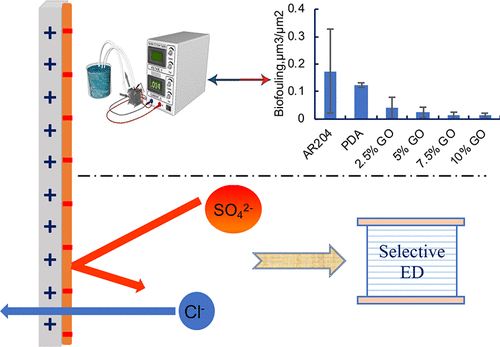当前位置:
X-MOL 学术
›
ACS ES&T Eng.
›
论文详情
Our official English website, www.x-mol.net, welcomes your
feedback! (Note: you will need to create a separate account there.)
Polydopamine-Assisted Modification of Anion-Exchange Membranes with Nanomaterials for Improved Biofouling Resistance and Electrodialysis Performance
ACS ES&T Engineering ( IF 7.4 ) Pub Date : 2021-04-22 , DOI: 10.1021/acsestengg.1c00065 Xuesong Xu 1 , Million Tesfai 1 , Guanyu Ma 1 , Wenbin Jiang 1 , Lu Lin 1 , Huiyao Wang 1 , Pei Xu 1
ACS ES&T Engineering ( IF 7.4 ) Pub Date : 2021-04-22 , DOI: 10.1021/acsestengg.1c00065 Xuesong Xu 1 , Million Tesfai 1 , Guanyu Ma 1 , Wenbin Jiang 1 , Lu Lin 1 , Huiyao Wang 1 , Pei Xu 1
Affiliation

|
The present study is the first to systematically investigate the impact of membrane modification on antifouling propensity and desalination performance of anion-exchange membranes (Ionics AR204) by codeposition of polydopamine (PDA) and TiO2 or graphene oxide (GO) nanomaterials. Ion-exchange capacity (IEC), surface hydrophilicity, overall desalting performance, and biomass accumulation on the membranes during biofouling experiments were analyzed to elucidate the impact of PDA and nanomaterials coating on membrane performance. All modified membranes exhibited marginal differences in IEC ranging between 2.19 and 2.45 mequiv/g as compared to the AR204 membrane of 2.40 mequiv/g. The modified membranes showed exceptional antifouling properties by the codeposition of PDA and nanomaterials (GO or TiO2). The cell attachment decreased by more than 98% at the TiO2 dosage of 5–10 wt %. The PDA-assisted TiO2 membranes observed a higher reduction in extracellular polymeric substances (88.6%–96.5%, the highest reduction at 10 wt %) than the PDA-assisted GO membranes (73.3%–88.7%, the highest reduction at 7.5 wt %). Bench-scale electrodialysis experiments revealed that membrane modification had a minor impact on the overall desalting performance, slightly reduced the energy consumption, and noticeably enhanced the monovalent permselectivity. The transport time for SO42– ions to pass through the interface between the modification layer and the membrane was significantly longer than for Cl– ions. The PDA-GO coating resulted in improved steric hindrance caused by the GO nanosheets because no change of impedance spectra was observed by electrochemical impedance spectroscopy compared to the unmodified AR204 membrane.
中文翻译:

用纳米材料对阴离子交换膜进行聚多巴胺辅助改性,以提高抗生物污染性和电渗析性能
本研究首次通过聚多巴胺 (PDA) 和 TiO 2或氧化石墨烯 (GO) 纳米材料的共沉积系统研究膜改性对阴离子交换膜 (Ionics AR204) 的防污倾向和脱盐性能的影响。分析了离子交换容量 (IEC)、表面亲水性、整体脱盐性能和生物污染实验过程中膜上的生物量积累,以阐明 PDA 和纳米材料涂层对膜性能的影响。与 2.40 mequiv/g 的 AR204 膜相比,所有改性膜在 IEC 范围内都表现出介于 2.19 和 2.45 mequiv/g 之间的边际差异。通过 PDA 和纳米材料(GO 或 TiO 2)。在 TiO 2剂量为 5–10 wt% 时,细胞附着减少了 98%以上。PDA 辅助的 TiO 2膜观察到胞外聚合物的减少更多(88.6%–96.5%,10 wt% 时的最大减少量)比 PDA 辅助的 GO 膜(73.3%–88.7%,7.5 wt% 时的最大减少量)更高%)。实验室规模的电渗析实验表明,膜改性对整体脱盐性能影响较小,能耗略有降低,单价选择性渗透率显着提高。SO 4 2–离子通过改性层和膜之间界面的传输时间明显长于 Cl –离子。PDA-GO 涂层改善了由 GO 纳米片引起的位阻,因为与未改性的 AR204 膜相比,电化学阻抗谱没有观察到阻抗谱的变化。
更新日期:2021-06-11
中文翻译:

用纳米材料对阴离子交换膜进行聚多巴胺辅助改性,以提高抗生物污染性和电渗析性能
本研究首次通过聚多巴胺 (PDA) 和 TiO 2或氧化石墨烯 (GO) 纳米材料的共沉积系统研究膜改性对阴离子交换膜 (Ionics AR204) 的防污倾向和脱盐性能的影响。分析了离子交换容量 (IEC)、表面亲水性、整体脱盐性能和生物污染实验过程中膜上的生物量积累,以阐明 PDA 和纳米材料涂层对膜性能的影响。与 2.40 mequiv/g 的 AR204 膜相比,所有改性膜在 IEC 范围内都表现出介于 2.19 和 2.45 mequiv/g 之间的边际差异。通过 PDA 和纳米材料(GO 或 TiO 2)。在 TiO 2剂量为 5–10 wt% 时,细胞附着减少了 98%以上。PDA 辅助的 TiO 2膜观察到胞外聚合物的减少更多(88.6%–96.5%,10 wt% 时的最大减少量)比 PDA 辅助的 GO 膜(73.3%–88.7%,7.5 wt% 时的最大减少量)更高%)。实验室规模的电渗析实验表明,膜改性对整体脱盐性能影响较小,能耗略有降低,单价选择性渗透率显着提高。SO 4 2–离子通过改性层和膜之间界面的传输时间明显长于 Cl –离子。PDA-GO 涂层改善了由 GO 纳米片引起的位阻,因为与未改性的 AR204 膜相比,电化学阻抗谱没有观察到阻抗谱的变化。











































 京公网安备 11010802027423号
京公网安备 11010802027423号